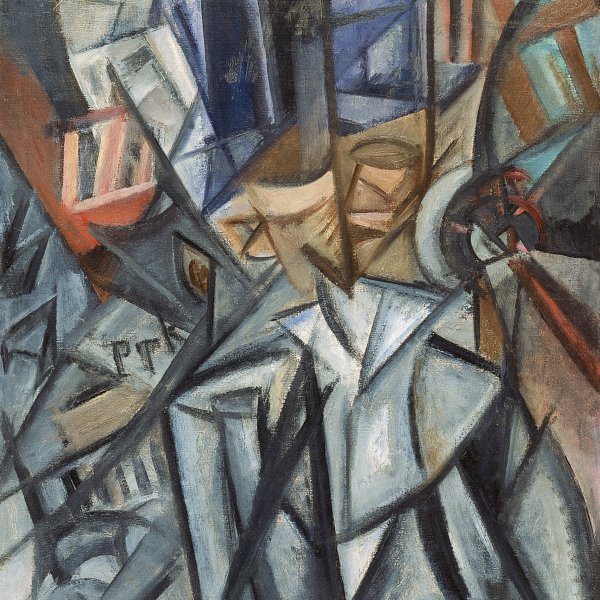Olga Rozanova
Melenki, 1886-Moscow, 1918
The Russian artist Olga Rozanova was one of the first advocates of nonfigurative art within the avant-garde movement in her country.
She studied in Bolshakov and, from 1904 to 1910, in Moscow with Konstantin Yuone and Ivan Dudin, and at the Stroganov School of Applied Arts. In 1911 she moved to Saint Petersburg, where she soon came into contact with the group of artists belonging to the Union of Youth movement and exhibited alongside them in the group’s first show in 1912. During this period the poet Alexei Kruchenykh, inventor of the zaum, also called absurd or “transrational” realism, introduced her to the Futurist aesthetic. Rozanova illustrated many of Kruchenykh’s publications, such as Te li le, and began to write zaum poems. In 1914 she met Filippo Marinetti and shortly afterwards her work was shown at the Prima esposizione libera futurista internazionale in Rome. She also took part in the Russian Futurist exhibitions Tramway V and 0.10. The Last Futurist Exhibition of Paintings held in Saint Petersburg in 1915.
Her interest in studying colour and simplifying forms, which is evident even in her early works painted in the Cubo-Futurist style that prevailed among the Russian artists of the day, steered her towards abstraction and led her to espouse Kazimir Malevich’s Suprematism. She collaborated with him and Liubov Popova in producing the magazine Supremus, of which no issues were ever published.
Following the Revolution of 1917, Rozanova became involved in various cultural initiatives, such as Proletkult (Proletarian Cultural Organisation) and took part in the preparations for the First of May celebrations. After her death in 1918 a major exhibition was staged in her honour in Moscow.
She studied in Bolshakov and, from 1904 to 1910, in Moscow with Konstantin Yuone and Ivan Dudin, and at the Stroganov School of Applied Arts. In 1911 she moved to Saint Petersburg, where she soon came into contact with the group of artists belonging to the Union of Youth movement and exhibited alongside them in the group’s first show in 1912. During this period the poet Alexei Kruchenykh, inventor of the zaum, also called absurd or “transrational” realism, introduced her to the Futurist aesthetic. Rozanova illustrated many of Kruchenykh’s publications, such as Te li le, and began to write zaum poems. In 1914 she met Filippo Marinetti and shortly afterwards her work was shown at the Prima esposizione libera futurista internazionale in Rome. She also took part in the Russian Futurist exhibitions Tramway V and 0.10. The Last Futurist Exhibition of Paintings held in Saint Petersburg in 1915.
Her interest in studying colour and simplifying forms, which is evident even in her early works painted in the Cubo-Futurist style that prevailed among the Russian artists of the day, steered her towards abstraction and led her to espouse Kazimir Malevich’s Suprematism. She collaborated with him and Liubov Popova in producing the magazine Supremus, of which no issues were ever published.
Following the Revolution of 1917, Rozanova became involved in various cultural initiatives, such as Proletkult (Proletarian Cultural Organisation) and took part in the preparations for the First of May celebrations. After her death in 1918 a major exhibition was staged in her honour in Moscow.





